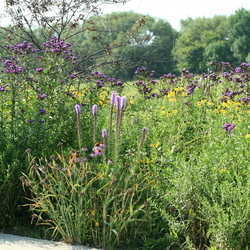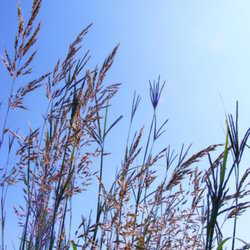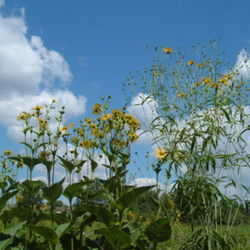(Editor's Note: This article was originally published on August 5, 2007.)
This is a good starting list for those who are looking for native plants for southern gardens. This is not a list of every native plant out there by far. But this is a list of many plants that are stunning in a southern garden. Any of these plants could be used in almost any gardening program. They will need less water than many of the plants most garden centers try to get us to buy. They will stand up to our long summers and they will love our shorter winters. These are prize-winning plants for our southern gardens that we only have to give minimal care to.
The most important plants to start the prairie garden are the grasses. There are three grasses that I use in my gardens that tend to look good and are nice team players. They are Andropogon geradii (big bluestem), Andropogon scoparius, (little bluestem), and Sorghastrum nutans, (indian grass). Big bluestem is a stunning grass if you have the space to give it room to grow. It grows to 6 feet tall and gains a wonderful orange color in fall. Little Bluestem is the plant for the smaller garden, gaining a height of 3 feet and a wonderful red color in the fall. Indian grass is the dominant species of most of the area. This grass is a great silver-blue color during the year and grows to 6 feet.
The flowering plants of the prairie are a more complicated matter. In the section below, most of the major plants can be used in the prairie garden and most of these plants can be used in any landscape garden as well.

Allium stellatum, (wild onion) is a wonderful plant that will grow in and out among other plants in your garden. The 24-inch stalks are crowned with wonderful pink flowers in the summer. The leaves, roots, and flowers are all edible and wonderful to use in salads or Tex-mex cuisine.

Asclepias tuberosa, Butterflyweed is the classic native butterfly weed that is well known in southern areas of the United States. The milkweed grows to about 36 inches tall and is covered with bright orange flowers. This is a classic butterfly plant but it is also a thrill to your local bees.

Asclepias viridis, (green milkweed) is just coming into its own in the garden in late summer. Much like its cousin butterflyweed, but green milkweed is a green version with large bell-shaped flowers. It grows to 18 inches tall and the flower clusters get bigger year after year. This is a great uncommon flower for the prairie garden; it should be used more often.

Aster oblongifolius (fall aster), is a stunning plant. The stiff stems are easy to propagate via cuttings. They love to grow and it is rather easy to move some of the roots to spread to other areas. The purple flowers are a show stopper when in bloom – they cover the plants building a wonderful purple cloud.

Baptisia australis (false indigo), is a very popular garden flower but few people know this wonderful flower is also a native. This plant grows to 4 feet high and has a good spread making it perfect for borders and prairie type garden situations. Their blue flowers are stunning when in bloom and will steal the show.

Baptisia leucantha, (white false Indigo) is the cream-colored complement to Baptisia australis. Growing to 4 feet and the same spread, this flower blooms in the heat of the summer when other flowers are clocking out. The cool cream color is perfect for the summer garden.

Cucurbita foetidissima, (buffalo gourd) is a large vine with bright, cheery flowers. This vine is hard to control in anything but a prairie garden, but well worth the effort if you have the space. The gourds are about the size of baseballs and useful in many Native American crafts.

Echinacea purpurea, (purple coneflower) is a classic native plant being planted in many areas. Few people know that this hardworking native brings the bees and hummingbirds into the garden. They also will sow freely in the right places and can dot a prairie garden in just a few years.

Echinocereus baileyi, (hedgehog cactus) is a great little prickly for the garden. Over time, this plant can attain a height of three feet and the blooms can be seen from across the yard. This is one of the few cactus plants that looks wonderful in the garden and is worth the risk of getting pricks.

Gilia rubra, (standing cypress) is a wonderful tall plant for drier areas of the garden. This plant can reach heights of up to 6 feet. The feathery leaves are topped with some of the brightest red flowers in the native plant kingdom. This is a real standout; just be sure to leave the seed heads alone for new seedlings year after year.
Liatris punctata, (gayfeather) is a longstanding flower that has been used in flowerbeds for many years now. L. puncatata is just one of the many species that grow in the wild and all of this species are stunning in the garden. Make sure the area for this plant is well drained or the bulbs tend to rot. This is a great plant for any type of garden.
















